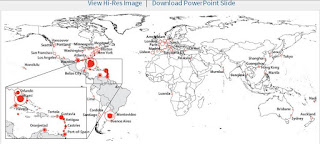
#11,172
Despite well publicized maps, like the one earlier this week from PLoS Currents Outbreaks: Potential Zika Virus Risk Estimated For 50 U.S. Cities, the potential geographic range of Zika carriage and transmission by local mosquitoes remains an open question, as we don't really know what species are competent vectors of the virus.
The Aedes Aegypti - which is a tropical mosquito, and limited in the United States pretty much to the Southern tier of states, is the only firmly established vector.
Other Aedes mosquitoes - particularly Aedes Albopictus - are suspected vectors, but their ability and efficiency in transmitting the Zika virus remains unproven. A. Albopictus has a much wider range than the A. Aegypti, and would extend the potential threat of local transmission to much of the Eastern half of the country, into parts of Canada, and even Europe.
It has also been speculated that other species, including the common Culex mosquito (see Fiocruz: Zika Virus Experimentally Introduced Into Culex Mosquitoes), might be competent vectors. But it will probably take several months before it can be proven one way or another.
For now, there are two main scenarios in play.
- Zika transmission only by Aedes Aegypti
- Zika transmission by both Aedes Aegypti and Aedes Albopictus
Last night a letter appeared in The Lancet, which stresses the importance of quantifying the transmission risk by species other than Aedes Aegypti - and particularly Aedes Albopictus - and offers up another potential transmission map based air traffic hubs and both Aedes species being competent vectors.
Follow the link to read:
Global risk of Zika virus depends critically on vector status of Aedes albopictus
Published Online: 17 March 2016
Constância F J Ayres1 recently pointed out that Zika virus has been collected from several mosquito species including those from the genera, Anopheles, Culex, and Mansonia besides Aedes. Moreover, at least ten Aedes species are known to harbour Zika virus. However, the presence of the virus does not automatically make the species an efficient vector for the disease. It is, therefore, unfortunate that a recent risk map published in The Lancet considers Aedes aegypti and Aedes albopictus together.2 On the same basis, WHO has predicted that the virus will establish itself in all countries in the Americas except Canada and Chile.3
However, while the vectorial competence of A aegypti is well established,4 that of A albopictus is not. Although there is evidence of the potential role of A albopictus,5 there is no quantitative estimate of its efficiency. It is, therefore, useful to conduct a risk analysis that considers two cases: spread driven by A aegypti presence alone and by both species.